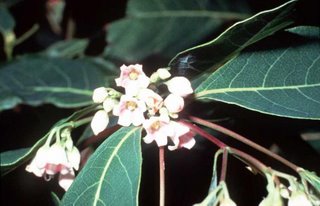
The plant of the day for Fructidor 8 is dogbane (also Indian hemp). The Latin name is apocynum cannabinum which also means poisonous to dogs, according to this Wikipedia article:
http://en.wikipedia.org/wiki/Apocynum_cannabinum
I am surprised that it is featured on the French Republican calendar as one source says it’s not found in western Europe, but another source mentions a dissertation written in Italy on apocynum.
It is native to North American and was used by the natives to treat syphilis, rheumatism, intestinal worms, fever, asthma, and dysentery. Michael Moore says the dried root can be used in a tincture as a vaso-dilating diuretic for dry skin, constipation and water retention. It can be used topically to induce sweat the tea stimulates the scalp. Mrs. Grieve says it is a cardiac tonic, like digitalis, and equally poisonous:
http://botanical.com/botanical/mgmh/h/hemcan21.html
The best article I’ve found on the web is this one from Plants of the Future:
http://www.pfaf.org/database/plants.php?Apocynum+cannabinum
It mentions many uses for the plant. The seeds can be ground into a powder and used as meal. The sap, if left to harden overnight, can be chewed as gum. The milky sap is also a folk remedy for venereal warts. The herb was used by North American Indians to treat rheumatism, coughs, pox, whooping cough, asthma, internal parasites, diarrhea and to increase milk flow in lactating mothers. The root is the most active part of the plant medicinally. A weak tea made from the root has been used for cardiac diseases and also to get rid of worms. But it’s most useful as a fiber. For this purpose, it’s harvested in fall, after the seed pods form. The stems are steamed, then cooked for two hours with lye and pounded with mallets. Or the stems can be left to dry in the winter. The fiber is tough, does not shrink and retains its shape in water.
Chelsie VandaVeer, of Killerplants.com, has several articles on dogbane:
http://www.killerplants.com/herbal-folklore/20021209.asp
and this one:
http://www.killerplants.com/renfields-garden/20021211.asp
which talks about how the dogbanes trap (and thus kill) insects.
It doesn’t look like I’ll be able to find it my area, based on this map produced by the Burke Museum, our local natural history museum:
http://biology.burke.washington.edu/herbarium/imagecollection.php?Genus=Apocynum&Species=cannabinum
References:
Moore, Michael, Medicinal Plants of the Pacific West, Red Crane Books 1993
Illustration:
Photo taken by a USDA employee which means it’s in the public domain. I found it at Wikipedia at
http://en.wikipedia.org/wiki/Image:Apocynum_cannabinum.jpg
1 comment:
Waverly, I am going to look for dogbane as I am sure I have seen it out in Lanark. I had no idea the plant has so many uses, but if it is a form of hemp (Indian Hemp), then the fibres would make wonderful textiles.
Post a Comment